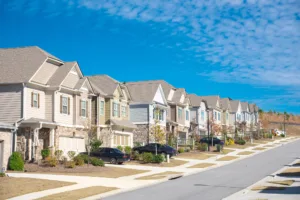What is an HOA and how does it work

Homeownership is a significant milestone. It’s a symbol of independence and financial stability. But with it comes responsibilities. One of these is understanding the role of a homeowners association, or HOA. An HOA is a governing body that oversees a residential community. It sets rules, maintains common areas, and collects fees for these services. But what does this mean for you as a homeowner? How does an HOA impact your daily life and financial obligations? This guide will delve into the workings of an HOA. It will shed light on its structure, benefits, and challenges. By the end, you’ll have a comprehensive understanding of HOAs. This knowledge will empower you to make informed decisions about your current or future home.
Understanding Homeowners Associations (HOAs)
Homeowners associations, or HOAs, play a crucial role in many residential neighborhoods. They’re often established by real estate developers. Initially, the developer sets up the HOA to manage common property and uphold community standards.
Once the community is established, control of the HOA transitions to the homeowners. This process typically involves electing a board of directors from among the residents. The board is responsible for maintaining the community’s overall well-being.
HOAs can govern and work various types of communities. These include condominiums, townhouses, and single-family home developments. The common thread is shared governance and maintenance of communal areas.
The role of an HOA extends beyond just maintenance. It also involves enforcing rules that enhance community harmony and property values. These rules are usually outlined in governing documents, including the Declaration of Covenants, Conditions, and Restrictions (CC&Rs).
Typical responsibilities of an HOA include:
- Maintaining shared spaces and amenities
- Managing community finances and budgets
- Enforcing rules and handling disputes
- Planning and conducting community meetings
Together, these elements create a structured environment for residents. While HOAs offer many benefits, they also come with certain obligations, which homeowners need to understand before joining a community.
The Purpose and Role of an HOA
The primary purpose of an HOA is to manage community properties and enforce rules. These rules help maintain a certain standard in the neighborhood.
By doing so, HOAs ensure the community remains pleasant and attractive. This is not only beneficial for current residents but also appealing to potential homebuyers.
Additionally, HOAs work with preserving property values. They do this by maintaining common areas and resolving issues that might detract from the community.
Community engagement is another vital role. HOAs often organize events and foster community spirit. This sense of belonging can enhance the quality of life for all residents.
It’s important to note that an HOA is not an external entity. Rather, it’s a collective of property owners who work for the benefit of everyone involved. This collective nature encourages residents to participate actively in community governance and decision-making.
The Structure of HOAs: From Condos to Single-Family Homes
HOAs can govern a wide range of residential properties, each with its unique structure. Condos, for example, are common in urban settings. Their HOA focuses on shared spaces like lobbies, gyms, and pools.
In contrast, townhome HOAs might manage shared walls and roof structures, as well as common areas. This ensures uniform maintenance and aesthetic consistency.
Single-family home communities often have working HOAs too. These associations maintain amenities such as clubhouses and community parks. They also manage landscape maintenance and other shared services.
Each type of community has its specific needs. As such, their HOA structures are tailored to address these requirements effectively.
In all cases, the HOA board plays a central role. It acts as the governing body, making decisions and implementing rules. Homeowners usually have a say through voting on important matters, ensuring democratic processes are upheld.
Regardless of the property type, HOAs aim to promote community living and uphold property values. Understanding this structure helps residents know what to expect and how to participate.
The Benefits of Living in an HOA-Governed Community
Living in an HOA-governed community offers several perks. These often include enhanced amenities and well-maintained environments. Such benefits contribute to a better quality of life for residents.
One of the most significant advantages is access to shared amenities. Many HOA communities provide facilities such as pools, gyms, parks, and clubhouses. These amenities can enrich residents’ daily lives.
In addition to amenities, HOAs work to ensure communities are well-kept. This includes regular landscaping and timely repairs. By maintaining common areas, HOAs keep the neighborhood looking its best.
The governance provided by HOAs also supports community harmony. Rules and regulations contribute to peaceful and orderly living. This is particularly beneficial in larger communities where diverse interests may coexist.
Access to Amenities and Community Living
One of the primary benefits of an HOA is access to communal amenities. These can range from state-of-the-art gyms to beautifully maintained parks. Such amenities would be costly to maintain individually but are more affordable when shared.
Access to these facilities promotes an active and engaged lifestyle. Residents can enjoy recreational activities within their community. This convenience adds significant value to living in an HOA.
Shared amenities also foster a sense of community. They provide spaces where neighbors can connect and socialize. This builds friendships and strengthens community bonds, enhancing residents’ overall quality of life.
Property Value and Community Standards
Living in an working HOA-governed community can positively impact property values. HOAs maintain high standards for property upkeep and appearance. This consistency makes neighborhoods appealing to prospective homebuyers.
The collective maintenance of common areas ensures properties remain desirable. An attractive community can help sustain and potentially increase home values over time.
HOA rules often include guidelines that prevent neglect or deterioration. These standards ensure a uniform and appealing look throughout the community. As a result, residents benefit from living in a well-presented environment that retains value.
HOA Fees Explained
HOA fees are essential for the operation and upkeep of an HOA community. These fees are monthly or annual charges that homeowners contribute regularly. They ensure that shared amenities and common areas remain in excellent condition.
The amount homeowners pay varies depending on several factors. These include the community’s size, the number of amenities, and maintenance requirements. Each HOA determines its fees based on its specific needs and budget.
Here’s a glimpse of what HOA fees typically cover:
- Landscaping and lawn care
- Maintenance and repair of community amenities
- Security services
- Trash removal
- Utilities for common areas
- Insurance for community-owned property
Timely payment of these fees is crucial. They support the essential services and facilities that make HOA communities attractive. Non-payment can lead to penalties or legal action, emphasizing their importance. Many plan for these payments the same time they pay their mortgage.
What Do HOA Fees Cover?
HOA fees cover a wide array of services and expenses. Primarily, they finance the maintenance of common areas such as parks, walkways, and clubhouses. This ensures residents have access to safe and clean recreational spaces.
Another significant portion of HOA fees goes towards landscaping. Well-manicured lawns and gardens enhance the community’s aesthetic appeal. This maintenance creates a visually pleasing environment for all residents to enjoy.
Additionally, HOA fees often include costs for security. This may involve funding for gated entries, security cameras, or on-duty personnel. Such measures are put in place to ensure the safety and peace of mind of homeowners.
HOA fees also typically cover utilities for shared areas. These can include lighting for streets and common areas. They also might cover water and electricity for community pools and centers.
Special Assessments and Financial Management
Special assessments may occur when unexpected expenses arise. These are additional charges beyond regular HOA fees. Examples include major repairs or unforeseen damage requiring immediate attention.
Proper financial management by the HOA is crucial to avoid frequent special assessments. An HOA must plan and budget wisely. This ensures funds are available for both expected upkeep and emergency situations.
Transparency in financial decisions helps maintain trust within the community. Open communication about the need for special assessments is important. This helps homeowners understand the financial responsibilities necessary to maintain their community.
Governance and Participation in an HOA
The governance structure of an HOA is vital to its success. Central to this is the HOA board of directors. This group is responsible for decision-making and community management.
Homeowners elect the board members. Typically, these individuals are residents themselves, ensuring representation and accountability. The board’s decisions impact the community, highlighting the importance of participating in elections.
Participation extends beyond voting. Homeowners can attend meetings, where updates and issues are discussed. Engaging in these meetings keeps residents informed about community projects and challenges.
Homeowners play a crucial role in the community’s governance by:
- Voting in board elections
- Attending HOA meetings
- Volunteering for committees
- Providing feedback on community initiatives
Community involvement fosters a sense of belonging. When homeowners actively participate, they help shape the living environment. This collaboration between residents and the board leads to a vibrant and dynamic community.
The HOA Board of Directors and Their Responsibilities
The HOA board of directors is a governing body with specific duties. These duties include managing finances and enforcing rules. Board members act in the community’s best interests to ensure smooth operations.
The board creates and maintains the community’s budget. Proper financial management is crucial for funding amenities and services. This responsibility requires transparency and regular financial reporting.
Rule enforcement is another critical task. The board ensures compliance with the community’s CC&Rs. This maintains standards, ensuring a harmonious living environment. Board members address violations fairly, balancing individual rights with community needs.
Homeowner Rights and Involvement in Decision-Making
Homeowners in an HOA have specific rights. These rights enable them to influence the community’s direction. Knowing these rights is essential for active participation in governance.
One key right is voting in board elections. Voting determines who will represent homeowners’ interests on the board. Informed voting ensures capable leadership managing the community effectively.
Homeowners can attend open board meetings. These meetings offer insight into ongoing projects and financial decisions. By asking questions and providing input, residents contribute to informed decision-making.
In addition, homeowners have the right to propose changes. They can suggest amendments to rules or community practices. This involvement ensures that residents’ voices shape the community dynamics. Active engagement strengthens the HOA and enhances the living experience for all.
Navigating HOA Rules and Regulations
Navigating the rules and regulations of an HOA is crucial for harmonious living. These guidelines are designed to maintain community standards and protect property values. Homeowners need to be familiar with these rules to avoid conflicts and fines.
The cornerstone of HOA regulations is the Declaration of Covenants, Conditions, and Restrictions (CC&Rs). This document outlines the dos and don’ts within the community. Understanding these terms is vital before purchasing a property governed by an HOA.
In addition to CC&Rs, bylaws govern the operations of the HOA itself. These include rules on elections and board responsibilities. Bylaws ensure transparent governance and efficient community management.
Here are key elements often covered by HOA regulations:
- Architectural guidelines for home modifications
- Landscaping and yard upkeep standards
- Noise and nuisance restrictions
- Rules for using common areas and amenities
By understanding these aspects, homeowners can enjoy a cohesive community experience. Complying with regulations fosters a respectful environment. It also contributes to the overall appeal and desirability of the neighborhood.
Understanding and Complying with CC&Rs
CC&Rs form the backbone of any HOA community. They are crafted to maintain uniformity and order among homeowners. Whether it’s prohibiting certain paint colors or regulating fence heights, these rules aim to uphold aesthetic harmony.
Compliance begins with education. Homeowners should thoroughly read the CC&Rs upon moving in. This prevents unintentional violations and promotes smooth interactions with neighbors and the board.
Sometimes, the language in CC&Rs can be complex. Seeking clarification from the HOA board is advisable if confusion arises. The goal is to ensure everyone is on the same page, promoting a shared understanding and community cohesion.
The Enforcement of HOA Rules and Handling Violations
Enforcing rules is essential to the integrity of an HOA. The board takes on the task of ensuring that all community members adhere to the established guidelines. This helps prevent situations where some individuals benefit at the expense of others.
When a violation occurs, the board typically initiates a process. This might involve issuing a warning or notice first. Often, the board prefers to resolve issues amicably and without immediate penalties.
Should violations persist, fines or other sanctions may be imposed. The board aims for consistency and fairness in enforcement. Homeowners are encouraged to communicate openly if disagreements or misunderstandings arise during this process. This engagement helps maintain trust and transparency within the community, while also reinforcing the value of adhering to agreed-upon standards.
The Challenges and Considerations of HOA Living
Living in an HOA-governed community presents unique challenges and considerations. While the structure fosters community standards, it may not suit everyone. Prospective buyers should weigh the benefits against potential downsides.
HOAs work to impose certain restrictions that could feel limiting. These rules are meant to preserve uniformity but can hinder personal expression. It’s essential to assess if these constraints align with your lifestyle preferences.
Another consideration is the financial obligations associated with HOA living. Regular fees can increase over time, impacting your budget. Understanding these financial commitments is crucial when deciding on a home purchase.
Here’s a quick look at common challenges faced in HOA living:
- Limited freedom in home alterations
- Potential for increasing fees and special assessments
- Risk of conflicts with the HOA board or neighbors
- Obligations to attend meetings and participate in decisions
Knowing these factors helps in making an informed decision about HOA living. Engaging with other residents and attending meetings can also provide deeper insights into the community dynamics.
Potential Downsides and Restrictions
Despite their benefits, HOAs come with downsides that can impact day-to-day living. Restrictions on home improvements, such as painting exteriors or installing new features, might frustrate homeowners. These rules, while ensuring harmony, often limit personal choices.
Another downside is the compulsory nature of HOA fees. Even if you don’t use all amenities, you still contribute financially. These fees are non-negotiable and support community services and upkeep.
Finally, the decision-making power of the HOA board can lead to conflicts. Disagreements over regulations or community policies may arise, leaving homeowners feeling unheard. It’s important to consider if you’re comfortable with this level of oversight before choosing to live in an HOA community.
Conflict Resolution and Legal Issues
Conflicts in HOA communities can stem from violations or board decisions. It’s crucial to address issues promptly and constructively to maintain harmony. Open communication often resolves misunderstandings before they escalate into significant disputes.
Most working HOAs have established procedures for conflict resolution. These may involve mediation sessions or formal appeals processes. Understanding these protocols is vital in navigating disagreements amicably and legally.
Should legal issues arise, like non-payment of dues or severe violations, legal action might be necessary. HOAs can place liens on properties or take other measures for unresolved disputes. Therefore, being informed of your rights and responsibilities within the HOA helps in protecting your interests and fostering a cooperative living environment.
Is an HOA Right for You?
Deciding if a working HOA-governed community is the right fit involves careful thought. Weighing the benefits of community standards and amenities against potential restrictions and costs is essential. Every homeowner values different aspects of living, so assess what matters most to you.
Consider visiting the community to get a firsthand feel of its environment. Speak with current residents to understand their experiences and challenges. Your comfort with the rules and shared responsibilities will guide your decision. Ultimately, choosing an HOA community should align with your lifestyle and financial preferences, ensuring a harmonious living experience.


